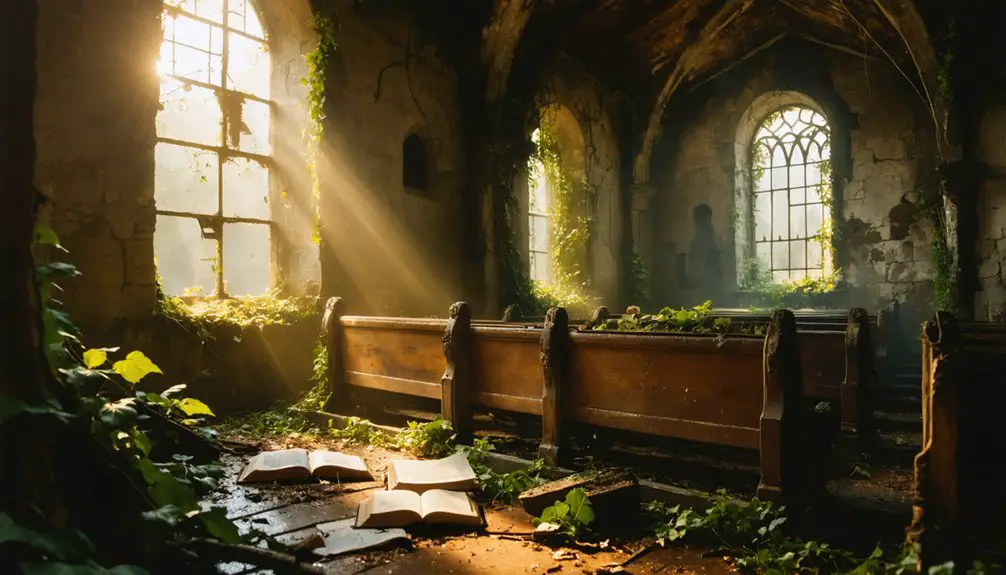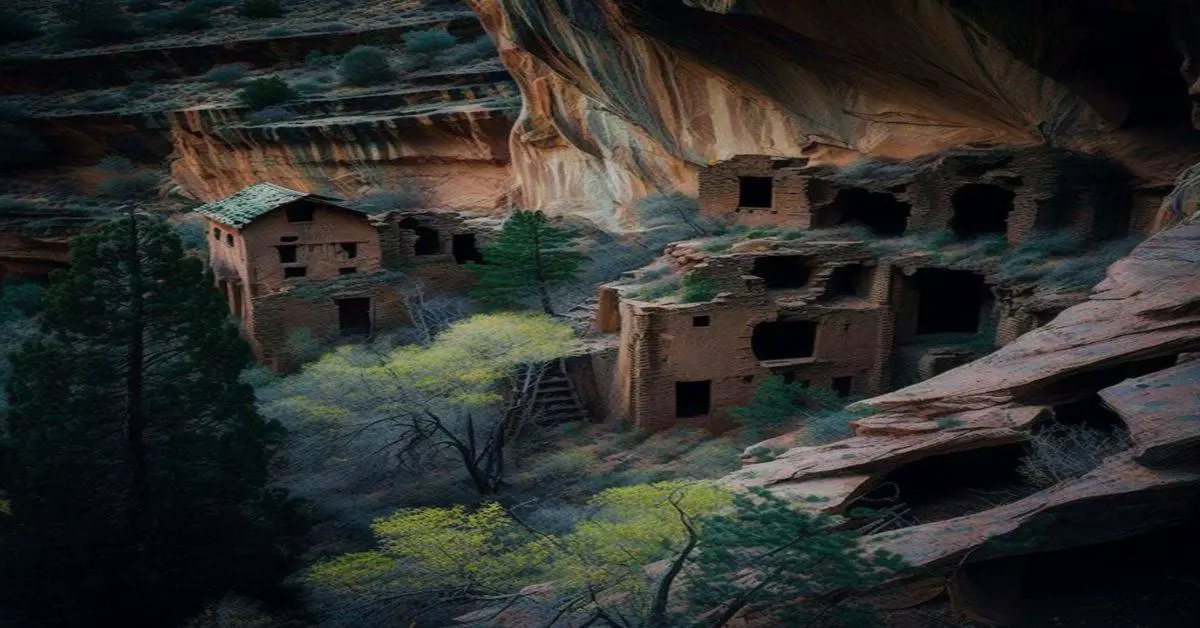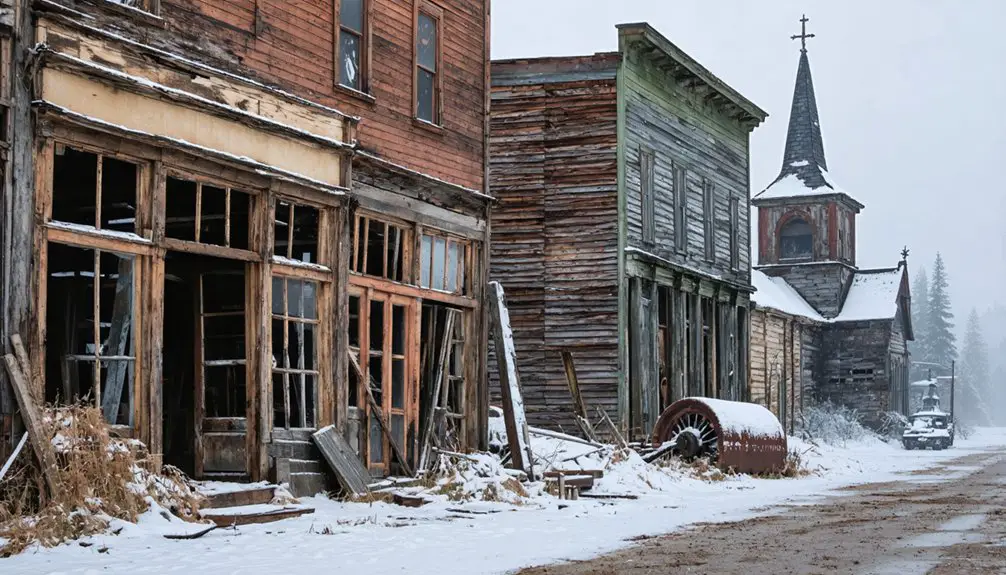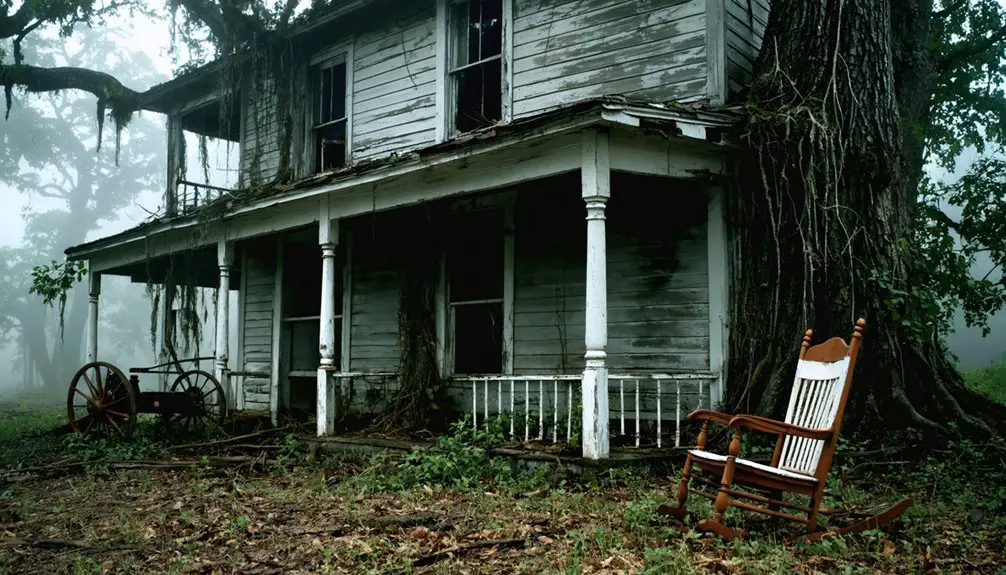You’ll find Pearlytown nestled deep in West Virginia’s Appalachian Mountains, where coal mining thrived from 1810 until 2025. The company town grew around its mines, complete with company houses and a store using scrip currency. When the mines closed in 2025, laying off 500 workers, families left seeking work elsewhere. Today, nature’s reclaimed most structures, with thick vegetation covering old foundations. The ghost town‘s quiet trails hold stories of America’s coal mining heritage.
Key Takeaways
- Pearlytown was a coal mining community established in West Virginia during the 1800s, centered around company-controlled mining operations.
- The town’s infrastructure included company-owned houses, a company store, church, and school built to support mining operations.
- Economic decline began with mine closures and layoffs in 2025, affecting 500 miners and leading to mass exodus.
- Nature has reclaimed the abandoned town, with vegetation covering old foundations and wildlife returning to former mining sites.
- The ghost town is now only accessible via dirt roads or hiking trails, with preservation efforts led by local historians.
The Rise of a Coal Mining Community
While coal’s presence in West Virginia had been known since John Peter Salley’s 1742 discovery, the region’s transformation into a mining powerhouse didn’t begin until the early 1800s.
Y’all can trace Pearlytown’s heritage to that pivotal era when the first commercial coal mines opened near Wheeling in 1810.
Like the low volatile coal that made the New River Coalfield famous, the mining legacy of communities like Pearlytown grew stronger with each passing decade.
When the Baltimore and Ohio Railroad reached Piedmont in 1843, it opened up new markets for coal shipping.
By 1873, the Chesapeake and Ohio Railroad’s arrival sparked a boom in coal town development.
Mining companies built entire communities, complete with company stores and worker housing.
The pattern was clear – wherever the railroads went, thriving coal towns like Pearlytown would soon follow.
Production surged dramatically, with coal output rising from a modest 489,000 tons in 1869 to an astounding 89 million tons by 1917.
Life in the Company Town
As workers poured into Pearlytown during the coal boom, they found themselves living in a carefully stratified community designed and controlled by the mining company.
You’d spot the company hierarchy right away – the superintendent’s mansion sat prominently on high ground, while white miners got decent houses on the outskirts, and Black and immigrant workers were relegated to the least desirable areas near the mines.
The company’s community control touched every part of your life. They ran the store where you’d buy groceries on credit, provided your utilities, and even controlled the law enforcement. These towns would typically include a company store, tipple, and dwellings centered around the mine operations.
While you’d enjoy modern amenities like electricity before nearby rural towns did, you’d trade your independence for these comforts.
Everything from your church to your children’s school fell under company oversight, making it mighty hard to break free from their influence.
When the United Mine Workers gained influence in the 1930s, workers finally had an organized voice against company control.
Mining Operations and Economic Impact
In Pearlytown’s early days, you’d see miners extractin’ coal through traditional underground methods, with teams workin’ long hours in dangerous conditions to bring the black rock to the surface.
Miners lived entirely at the mercy of coal companies, with low pay and housing provided only as long as they stayed employed. The company paid workers in scrip instead of cash, which meant you could only spend your earnin’s at the company store, keepin’ the town’s whole economy under tight company control.
By 1947, many local operations had shifted to surface mining to meet the growin’ demand for coal durin’ and after World War II.
Coal Production Methods
During the early 1800s, coal mining in Pearlytown began with small-scale surface operations that primarily served local blacksmiths and domestic needs.
By the late 1800s, you’d have seen a dramatic shift as deep shaft mining techniques took over, especially after they discovered the Pittsburgh Coal Seam. Mining operations spread in a grid pattern layout, with miners leaving pillars of coal in place to support the mine roof.
Mining methods got a real boost in the 1920s when mechanized coal extraction came into play.
You’d find specialized infrastructure that made the work more efficient, like mountain haulage systems moving both miners and coal between different levels.
Before shipping the coal out, they’d process it right there on site – washing and preparing it to fetch better prices.
The railroad’s arrival in the 1870s changed everything, connecting Pearlytown’s coal to national markets and fueling the region’s rapid growth in production.
Company Town Economics
While most coal towns emerged organically, Pearlytown started as a deliberate company venture that controlled every aspect of miners’ lives. The company swiftly constructed uniform houses, with better homes for supervisors and basic dwellings for workers. These mining communities reflected class and racial divisions through their distinct housing arrangements and neighborhood layouts. Private detectives patrolled the streets to monitor worker activities and maintain company control.
You’d find the mine entrance, tipple, and company store all strategically placed near the railroad tracks.
The economic chains binding miners to Pearlytown were tight. You couldn’t escape the scrip system – those company-issued tokens that forced you to shop at the overpriced company store. Without access to real U.S. currency, you’d fall deeper into debt with each payday.
The company owned everything – your house, your job, even your shopping choices. When the coal seams eventually dried up, Pearlytown’s dependency on this single industry left workers with nowhere to turn.
Daily Experiences of Coal Miners
Deep beneath the earth’s surface, coal miners endured grueling daily conditions that tested both body and spirit.
You’d enter the shaft before dawn, your hard hat lamp cutting through pitch-black tunnels stretching miles underground. Despite the miner’s camaraderie that kept spirits alive, underground hazards lurked at every turn – methane gas, roof collapses, and the constant threat of suffocation.
Working “by the ton” meant longer shifts than the standard eight hours, operating dangerous machinery like continuous miners and roof bolters. Your lungs would fill with coal dust while you sweated in cramped spaces. These dedicated workers earned average annual pay $45,000 for their dangerous underground work.
After emerging from the darkness, you’d head home to a company-owned house, spend scrip at the company store, and rest your aching body before starting it all again tomorrow.
Architecture and Infrastructure
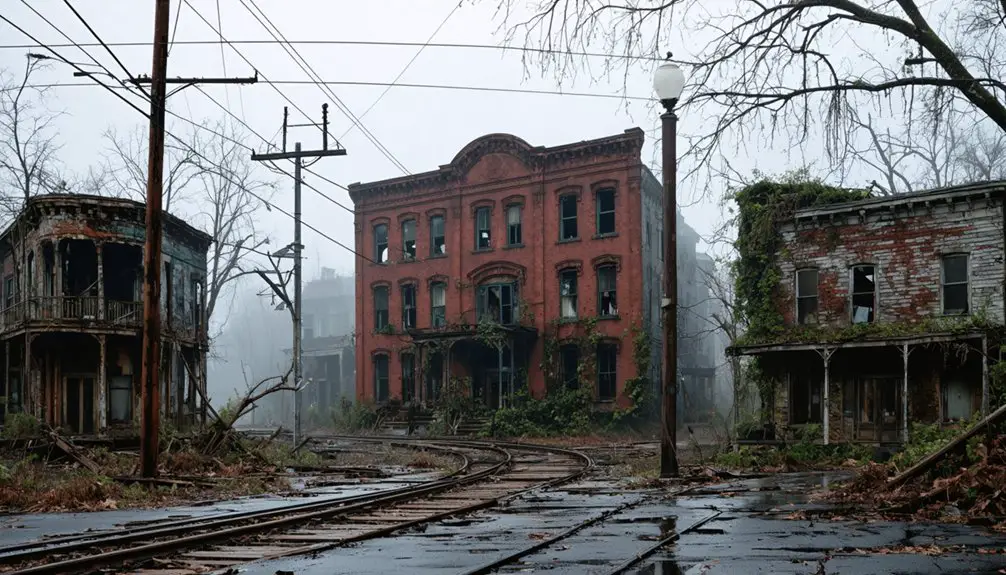
As Pearlytown evolved from a bustling coal hub to a ghost town, its architectural remnants tell the story of its rise and decline.
You’ll find traces of its heyday in the remains of the 1905 engine house, where four steam locomotives once roared to life under the care of 175 skilled workers.
The grand Dun Glen Hotel, with its 100 rooms and modern amenities, stood proud until a mysterious fire claimed it in 1930.
Standing majestically in Pearlytown, the luxurious Dun Glen Hotel met its fiery demise in 1930, taking a century of memories with it.
Today, the National Park Service fights to preserve what’s left – from boarded-up town halls to the James Humphrey House.
Churches, like the 1927 Thurmond Union Church, remind y’all of a time when faith united the community.
While many structures have succumbed to time, historic preservation efforts keep Pearlytown’s story alive through its surviving architectural remnants.
Social Dynamics and Community Relations
Life in Pearlytown revolved around the iron grip of the coal company, which controlled nearly every aspect of daily existence. You’d find yourself living in company housing, shopping at company stores with scrip wages, and sending your young’uns to company schools.
The mining bosses sat atop the social ladder while regular folk banded together in tight-knit neighborhoods, often grouped by ethnic backgrounds. Your community identity grew from shared struggles in the mines and the boom-and-bust cycles that kept everyone on edge.
Social cohesion emerged through company-sponsored gatherings at the church or community hall, but it was the common burden of dangerous work and economic uncertainty that truly bound folks together.
When the mines finally closed, that same shared experience led to mass exodus as families sought work elsewhere.
The Final Days of Coal Production
In those final days of Pearlytown’s coal production, you’d see fewer and fewer miners heading down into the shafts as mechanization and declining demand forced operations to scale back.
By the mid-20th century, you’d notice the once-bustling rail lines growing quiet, with coal cars making their last runs through the New River Gorge region.
The miners who’d spent their lives working these seams now faced tough choices – stay and hope for other work, or join the growing exodus from West Virginia’s coal communities.
Mine Operations Wind Down
The once-prosperous coal mines of Pearlytown entered their final chapter during the mid-to-late 20th century, when declining output and market shifts forced many operations to shut down.
You’d have seen mining technology elsewhere advancing rapidly, leaving Pearlytown’s smaller operations struggling to compete. Despite the community’s resilience, the mines couldn’t sustain profitable production from their thinning coal seams.
In those waning days, you’d find miners working drift and slope mines with limited mechanization, often revisiting previously mined areas with supplemental drilling.
The workforce dwindled as veteran miners faced layoffs or transfers. Company stores closed their doors, rail spurs fell silent, and the economic foundation of Pearlytown crumbled.
The mining infrastructure – from tipples to transport systems – was gradually abandoned or dismantled.
Workers Face Uncertain Future
While Pearlytown’s coal industry had weathered many storms before, the summer of 2025 brought devastating news as nearly 500 miners faced sudden layoffs across southern West Virginia.
You’d see it first at Civil LLC’s C-V 2 mine, where 135 miners and 20 prep plant workers got their notices, then at Itmann Mine where another 200 workers lost their jobs.
Folks started talkin’ about job retraining programs, but with China dumpin’ cheap steel and coal prices in the gutter, there weren’t many options close to home.
Community support initiatives popped up, and the Governor promised to find new opportunities, but you could feel the uncertainty in the air.
Some miners held out hope that new owners might restart operations, while others packed up and left Pearlytown behind.
Empty Rails Stand Silent
Rusty rails stretched far as the eye could see by fall 2025, with not a single coal car rollin’ through Pearlytown’s once-busy rail yard. You’d hardly believe these tracks once carried millions of tons of coal, now just economic remnants of a bygone era.
Railway nostalgia hits hard when you walk these silent corridors where freight trains used to thunder day and night. The rail company pulled out maintenance crews years ago, leaving the tracks to nature’s whims.
Some folks switched to trucking coal, but it wasn’t near as efficient as the old rail system. Now these abandoned lines are just gathering rust, while environmental crews tackle the coal dust left behind.
What used to be the lifeblood of Pearlytown’s economy stands as a stark reminder of how quickly things can change.
Nature’s Reclamation of Pearlytown
Since Pearlytown’s abandonment, nature has steadily reclaimed the once-bustling settlement through an intricate process of ecological succession.
You’ll find thick vegetation recovery everywhere – native oaks and hickories push through old foundations, while poison ivy and wild grape vines strangle the remaining structures. The dense underbrush now conceals what’s left of the old streets and buildings beneath layers of seasonal leaf litter.
Wildlife resurgence tells its own tale of renewal. Raccoons and squirrels have made homes in the crumbling ruins, while woodpeckers echo through the young forest.
Nature’s tenants have moved in swiftly – raccoons nest in old walls while woodpeckers drum new rhythms through the recovering woodland.
White-tailed deer and foxes wander freely where townsfolk once walked. The abandoned mine pits, now filled with water, serve as breeding grounds for frogs and salamanders.
Year by year, Pearlytown surrenders more of its man-made features to the persistent force of nature.
Historical Preservation Efforts
As nature steadily claims Pearlytown’s remains, local historians and volunteers work to preserve what they can of the historic settlement.
Without official historic site designation, preservation strategies rely heavily on community engagement and grassroots efforts.
You’ll find dedicated volunteers facing significant challenges in their preservation work:
- Small groups conduct periodic cleanups of debris and invasive vegetation
- Volunteer photographers document remaining structures and collect oral histories
- Local historians reach out to descendants to maintain cultural connections
- University archaeologists study artifacts when grant funding permits
The town’s remote location and private ownership status make regular maintenance difficult.
While heritage organizations push for protective status, bureaucratic hurdles slow progress.
Digital archiving and potential heritage tourism initiatives offer hope for future preservation, but the race against time continues.
Exploring the Ghost Town Today
The desolate remains of Pearlytown offer adventurous visitors a haunting glimpse into West Virginia’s coal mining past.
Abandoned since the mines closed, Pearlytown stands frozen in time, a ghostly monument to West Virginia’s industrial heritage.
You’ll find the ghost town tucked away in remote terrain, accessible only by dirt roads or hiking trails. Urban exploration enthusiasts frequently document the weathered foundations and rusted mining equipment, while photographers capture nature’s slow reclamation of the site.
You’ll need to come prepared – there aren’t any visitor facilities, and cell service is spotty at best. Wear sturdy boots and protective clothing, as you’ll encounter wildlife and unstable structures.
Spring and summer offer the safest conditions for exploring. While you’re in the area, you can extend your adventure to nearby Kay Moor or Thurmond, where you’ll find more preserved mining history and guided tours.
Frequently Asked Questions
Are There Any Documented Paranormal Activities or Ghost Sightings in Pearlytown?
Hold onto your hat – you’ll find well-documented ghost stories about children’s spectral sightings near the park’s swings, plus unexplained voices and footsteps around abandoned rides after darkness falls.
What Happened to the Mining Equipment After the Town Was Abandoned?
You’ll find most mining equipment was left behind, some got salvaged during wartime metal drives, while the rest rusted away underground. Only a few pieces survived for historical preservation efforts.
Did Any Original Residents Return to Live in Pearlytown?
Like autumn leaves scattered by time, original residents never found their way home. Town history shows no documented returns after the mass exodus, with private property restrictions keeping folks away permanently.
Were There Any Major Mining Accidents or Disasters in Pearlytown?
You won’t find any major mining accidents recorded for this area in historical records. While mining safety was a concern across West Virginia, there’s no documented proof of disasters happening right here.
What Native American Tribes Originally Inhabited the Area Before Pearlytown’s Establishment?
You’d find the Shawnee and Delaware were the main native tribes of historical significance here, though Paleo-Indians lived in the area first, followed by various Iroquoian and Siouan-speaking peoples.
References
- https://www.youtube.com/watch?v=-EeLwLa2t90
- https://kids.kiddle.co/List_of_ghost_towns_in_West_Virginia
- https://www.youtube.com/watch?v=yBKOIRxeNX0
- https://theclio.com/tour/1943
- https://aceraft.com/2021/06/25/haunted-thurmond-wv/
- https://minesafety.wv.gov/historical-statistical-data/mining-in-west-virginia-a-capsule-history/
- https://aceraft.com/new-river-gorge/new-river-gorge-national-park/history/coal-towns-of-the-new-river-gorge/
- https://en.wikipedia.org/wiki/West_Virginia_coal_wars
- https://www.averyreview.com/issues/35/making-coal-historical
- https://www.youtube.com/watch?v=P9HD52gXyRA
